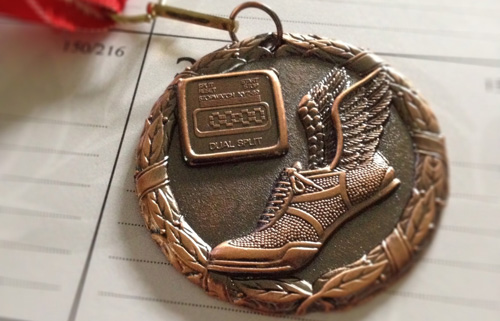
A few weeks ago, I reached one of my goals for 2012, a goal that I have been working on for about a year: I finished a timed 5k in under 30 minutes. If you are a runner you are probably saying “big whoop”‘ but if you know anything about me, you will understand why this is a big deal for me.
I’ve never been athletic. Yes, I was a dancer growing up, but all I really for out of dance class was some rhythm, and the ability to memorize choreography. When it comes to sports, I am hopeless: I have terrible hand-eye coordination, and I’ve quit every sport I’ve ever taken up. I even got a C in PE once, and that’s only because my teacher felt bad for me and didn’t want to give me a D.
How did I go from a klutz who hated running and couldn’t run for more than 30 seconds without getting winded to someone who’s finished two half-marathons and runs around 12 miles a week? Trust me, if I can do it, so can you.
Start by taking the Talk Test.
The reason most rookies give up on running is that they run too fast and feel like dying after the first minute. When you start running, try to have a conversation, even if you are by yourself. Yes, you’ll look like a lunatic, but who cares? You should be able to speak in complete sentences; if you can only get one or two words out, slow down! When I started running, I averaged about 15-minute miles. I was so slow that my husband could walk fast next to me while I was “running”. That was two years ago, and today I average a 9:45-minute mile.
Devise a plan.
You can’t just decide to start running one day and expect to run a 5k without stopping. Especially if you are a woman. Unfortunately biology has given us smaller hearts and lower lung capacities than men, so while your guy friends can typically get off the couch and into running at a pretty decent pace, you may find yourself lagging behind. Don’t be discouraged if it takes time to add mileage to your runs and shave seconds off your time. I used the program included in The Complete Idiot’s Guide to Running (yes, I bought the book, and find myself going back to it every few months to try new things). You don’t have to start at the very beginning of the program. If you can run for 5 minutes without stopping, you can jump in at the Week2/Workout 3 mark. I’ve gone off the wagon a few times due to illness and injuries, and always found it easy to get back into the schedule.
Look at your form.
Even after I was running a 10k without stopping, I was getting constant knee and hip pain, and I wasn’t really getting faster. After doing some research, I decided to try barefoot running and it [cue Chris Traeger] LITERALLY changed my running life. Yes, I was one of those hippies running in the “toe shoes“, and yes, it took me about 9 months to get back to my heel-strike mileage, but I am so glad I made the change. I believe changing my running stride from a heel-strike to a mid/forefoot strike has made me a faster runner, and I’ve had no significant injuries since the change. I have also ditched the bulky running shoes (and the Vibrams) for a pair (more like 3 pairs) of Nike Free 3.0 V3 running shoes. If you are injury-prone, or if you are flat-footed like me, you may want to look at changing your form instead of trying to fix your natural stance with stability shoes or orthotics. I found that the concepts in this DVD really helped when I was working on changing my running form, but what made the difference was running in barefoot-like shoes.
Part II will cover my tips for getting serious about your running. Do you love to hate running? Tell me about it in the comments!